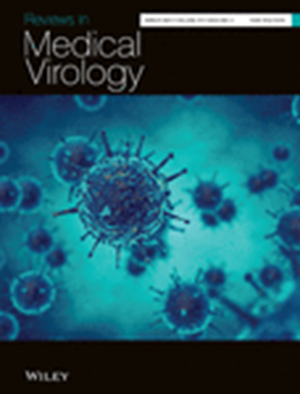利用基于生物传感器的方法识别神经病毒
IF 9
2区 医学
Q1 VIROLOGY
引用次数: 0
摘要
神经性病毒具有入侵中枢神经系统的能力,可引起一系列神经系统疾病,对公共卫生构成重大挑战。神经性病毒感染的临床表现千差万别,从轻微到危及生命,如 HSV 引起的脑炎或脊髓灰质炎病毒引起的脊髓灰质炎。传统的诊断方法,包括聚合酶链反应、血清学检测和成像技术,虽然很有价值,但也有局限性。为了应对这些挑战,基于生物传感器的方法已成为一种很有前途的方法。这些方法具有见效快、灵敏度高、特异性强等优点,并有可能在护理点应用。生物传感器以特定的生物标记物或遗传物质为目标,利用表面等离子体共振和微阵列等技术,为诊断神经性感染提供了一种直接而有效的方法。本综述探讨了基于生物传感器的方法的演变情况,重点介绍了这些方法在增强神经性病毒诊断工具包方面的潜力。本文章由计算机程序翻译,如有差异,请以英文原文为准。
Utilising biosensor-based approaches for identifying neurotropic viruses
Neurotropic viruses, with their ability to invade the central nervous system, present a significant public health challenge, causing a spectrum of neurological diseases. Clinical manifestations of neurotropic viral infections vary widely, from mild to life-threatening conditions, such as HSV-induced encephalitis or poliovirus-induced poliomyelitis. Traditional diagnostic methods, including polymerase chain reaction, serological assays, and imaging techniques, though valuable, have limitations. To address these challenges, biosensor-based methods have emerged as a promising approach. These methods offer advantages such as rapid results, high sensitivity, specificity, and potential for point-of-care applications. By targeting specific biomarkers or genetic material, biosensors utilise technologies like surface plasmon resonance and microarrays, providing a direct and efficient means of diagnosing neurotropic infections. This review explores the evolving landscape of biosensor-based methods, highlighting their potential to enhance the diagnostic toolkit for neurotropic viruses.
求助全文
通过发布文献求助,成功后即可免费获取论文全文。
去求助
来源期刊

Reviews in Medical Virology
医学-病毒学
CiteScore
21.40
自引率
0.90%
发文量
88
期刊介绍:
Reviews in Medical Virology aims to provide articles reviewing conceptual or technological advances in diverse areas of virology. The journal covers topics such as molecular biology, cell biology, replication, pathogenesis, immunology, immunization, epidemiology, diagnosis, treatment of viruses of medical importance, and COVID-19 research. The journal has an Impact Factor of 6.989 for the year 2020.
The readership of the journal includes clinicians, virologists, medical microbiologists, molecular biologists, infectious disease specialists, and immunologists. Reviews in Medical Virology is indexed and abstracted in databases such as CABI, Abstracts in Anthropology, ProQuest, Embase, MEDLINE/PubMed, ProQuest Central K-494, SCOPUS, and Web of Science et,al.
 求助内容:
求助内容: 应助结果提醒方式:
应助结果提醒方式:


